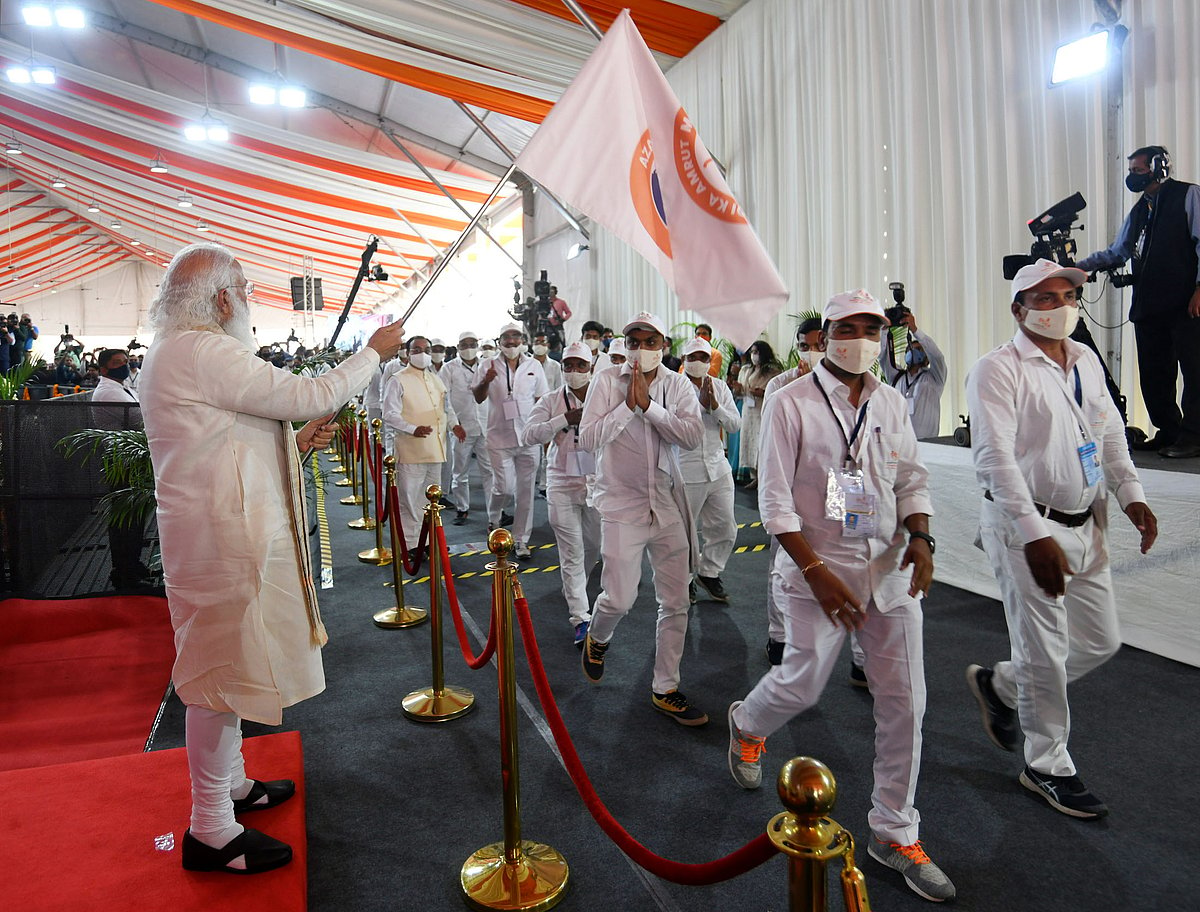Would Gandhi have led another symbolic Dandi Yatra to oppose ‘Might is Right’?
As the country gears up to celebrate the 75th anniversary of Independence, the deeper symbolism of the freedom struggle cannot but resonate with irony, writes Mrinal Pande

Most literate Indians take care to read the documents and the fine print carefully before investing in Mutual Fund. But when it comes to commemorating landmarks of history, most politicians and people fail to read up history.
Now that Mahatma Gandhi has been amusingly and ironically appropriated by the RSS and the BJP, commemorating events associated with the Mahatma have been turned into glitzy events where politicians put on ritualistic Gandhi caps, arrange for a spinning wheel and round up a group of Bhajan singers to sing at Raj Ghat, Bapu’s samadhi. With the press of a button and the wave of a flag, the spectacle is complete.
There has been no dearth of such spectacles in the last six years; and speeches on such occasions betray the Schizophrenia of the ruling class, who revile freedom fighters the rest of the year but on such occasions do not even blink before recalling the contributions of the likes of Jawaharlal Nehru, Vallabhbhai Patel and Maulana Abul Kalam Azad.
The commemoration of the historic Dandi March of 1930 this week was no different. The Union Government formally launched the 75th anniversary celebrations of India’s Independence on March 12 with the Prime Minister flagging off a commemorative march from Ahmedabad to trace the 385 Km route taken by the Mahatma and freedom fighters in 1930. The re-enactment of the Yatra by 301 people marked the 91st anniversary of the march.

In 1930 the march was a symbolic act of defiance against the then British government’s control of everyday life extending to the ban on people living on the coast to turn sea water into salt. Mahatma Gandhi’s grandson Rajmohan Gandhi recalled that the British rulers did not take the march seriously at first. They took it as a joke. The Statesman editorially commented that there was something childishly theatrical in challenging British monopoly with a silly march.
The colonial government did not arrest Gandhi immediately in order to avoid enhancing his stature. But Sardar Patel was arrested at Kheda even before the march began. He had lost his right hand, lamented the Mahatma. But if leaders fell by the way, got arrested or died in prison, he reassured people, new leaders would take their place. And true enough, Rajagopalachari in the South, Rajendra Prasad in Bihar, JM Sengupta in Bengal, Mahadev Desai in Gujarat and Khan Abdul Ghaffar Khan in the frontier province rose to the challenge.
The march electrified the country, writes Rajmohan Gandhi. It was followed by a civil disobedience movement and signaled the beginning of the end of the British empire in India.
But in keeping with the attempts of the current dispensation to rewrite history, Congress leaders were not invited to the event. Typically, the event turned into a partisan affair with ruling partymen, who of course had played no role in freedom struggle and who actually collaborated with the British rulers, appropriating it.
The Prime Minister flagged off the event at Abhay Ghat ground near the resting place of a late Gujarati Gandhian later turned rebel, Morarji Bhai. The event was attended by VIPs including the Chief Minister and the Governor of the state.
The Prime Minister who heads the Committee constituted to oversee the celebrations, took care to visit the Sabarmati Ashram, garlanded the bust of Gandhi and sprinkled fresh rose petals. Then he stood, resplendent in his white attire, waving the flag for the marchers, who went past him with a nod and a smile.
The Yatra was not led personally by the Prime Minister, who had many important jobs at hand. Instead, the Union Minister of State for Culture and Tourism Prahlad Patel led the Yatra up to Nadiad. He told the media that 81 marchers would complete the entire journey on foot and arrive at Dandi on 5th April. The event also included a “cultural programme” that included dance, music, singing of some of Bapu’s favorite hymns and reading of the Preamble to our Constitution.
Not to be outsmarted by the BJP led government at the Centre, Arvind Kejriwal, Chief Minister of Delhi, declared it would hold another festival in Delhi at Rajiv Chowk in Delhi with theatre performances, tributes to freedom fighters of Delhi and a flag march!
Kalidasa once said that being a writer of grand history (of the clan of Raghus in his case), is like trying to cross an ocean in a boat made of leaves strung together. Being the Prime Minister of India in 2021 with a Covid battered economy, China, Russia and Pakistan baying at its door and global warming threatening to bring the seismically active roof of the world, the Himalayas, on its head any time with a ‘Big One’, would have made the Prime Minister feel like Kalidasa did.
We wait with bated breath. Is the re-enactment of the Dandi March throw up new leaders as Gandhi had predicted 91 years ago? With the Government of the day increasingly behaving like old, colonial masters and as people continue to be oppressed, will the country be electrified by new movements and new leaders? Indian media, with new Information Technology laws hanging like a sword over its head, Mahatma Gandhi’s words before the March, may well resonate “I want world sympathy in this fight for right against might.”
Follow us on: Facebook, Twitter, Google News, Instagram
Join our official telegram channel (@nationalherald) and stay updated with the latest headlines
